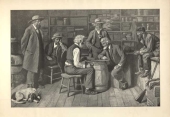The Checker Maven
The World's Most Widely Read Checkers and Draughts Publication
Bob Newell, Editor-in-Chief
Published every Saturday morning in Honolulu, Hawai`i
Noticing missing images? An explanation is here.
Uncle Ben's Porch: Making Varsity
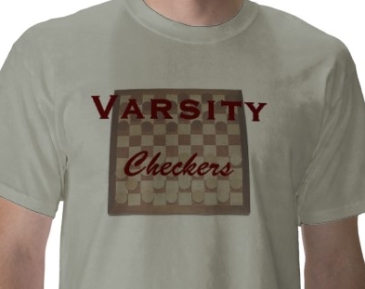
Tommy had a very important match coming up. There was one spot left on the varsity checker team for the coming school year; Tommy, as Captain of the junior varsity, had a shot at it.
Coach Hovmiller tried to be fair about these things. He set up a series of test matches and promoted the players who had the best scores combined with the best attributes such as team play, sportsmanship, and so on. Tommy ranked well in all of the latter factors, but he was having a run of bad luck with the test matches.

It wasn't that Tommy was a poor player; he was one of the best. But he'd blundered in one game and had a loss of confidence, quickly losing two more. Coach Hovmiller knew that Tommy was better than that, but he wouldn't bend his own rules. Fair is fair, and Tommy had to win the next match to gain a varsity position.
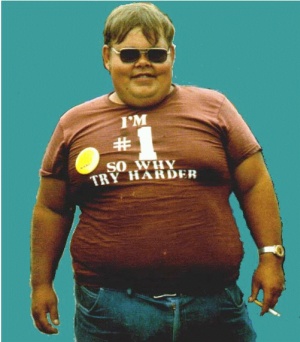
The trouble was, the match was with Joey Zee, and Joey was not a very nice boy (see previous Checker Maven column). Joey was almost dropped from the team by the Coach several times during the year for his bad behavior. He had no chance at a varsity position, but Tommy still had to play him to complete the round-robin competition, and Joey would like nothing better than to knock Tommy out of the running. Joey was always calling Tommy "goody two-shoes." Worse, Joey wouldn't leave teammate Tina Tooner alone, and Tommy and Tina had recently become friends in the way that a young boy and a young girl will do.
Joey was insanely jeaous, and Tommy had no idea what he might do. Joey was known to cheat when he could get away with it, and was the author of no end of dirty tricks and mean stunts.

Tommy was on Uncle Ben's porch, as was common most Saturday mornings. Uncle Ben, a retired master player, had some years ago taken Tommy under his wing and given him weekly lessons, always accompanied by a pitcher of his delicious lemonade. He wasn't really Tommy's uncle, of course, but Tommy called him that out of respect.
Tommy and Uncle Ben had developed a very close and open relationship. Tommy often sought the old gent's advice, and this was one of those times. He had just finished explaining to Uncle Ben his loss of self-confidence and his intimidation at having to play Joey Zee on Tuesday afternoon at after-school team practice.
"Everyone loses some games," Uncle Ben explained. "The old saying is that if you don't want to lose then don't play."
"I know, Uncle Ben, but I was doing so well ... "
"Tommy, a checker rating or a won and lost record only tells someone how well you've played in the past. It can't say for sure how well you'll play in the future. Do you know the difference between a great player and an average player?" Uncle Ben asked.
"Skill?" Tommy replied.
"Well, yes, of course, but there's something really fundamental. A great player learns from his losses, takes them in stride, and takes on the next game with confidence. A lesser player isn't able to do that. And Tommy, you're not a lesser player. You have the potential to possibly even rise to the professional ranks some day."
Uncle Ben wasn't liberal with compliments of this type; he didn't want his students to become overconfident or even arrogant. But this was the time to give Tommy's ego a little boost, and in any case, Uncle Ben knew that what he said was true, or he never would have said it.
"Really, Uncle Ben?"
"Yes, Tommy. Now, the problem you're having is that you're thinking too much about that varsity position, instead of thinking about each game and each move as it takes place. If you'll concentrate on trying to make the best move every time, and nothing else, you'll pull out of your slump before you can say 'Jack Robinson'."
"That makes sense, Uncle Ben. I'll do the best I can. But what about Joey? He's so mean and I don't know what he might do."
"Well, Tommy, you can't control that. But you don't have to let it get the better of you, either. Concentrate on playing your game. If Joey acts up, stop the clock and call for the Coach. Stop Joey dead in his tracks. And by all means remain a good sport yourself. Don't retaliate, don't do mean or foolish things yourself. Just play your game and make sure Joey knows that he can't bully you or get away with anything."
"Thanks, Uncle Ben," said Tommy. "That's great advice."

Uncle Ben was pouring lemonade and had turned to the checkerboard on the table in front of them. He passed a tall, frosty glass to Tommy and said, "Now try this one, and work on keeping your focus."
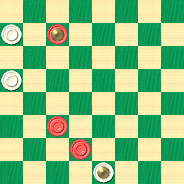
BLACK
Black to Play and Draw
B:B7,11,K27:W20,28,K2.
Tommy sat at the board for the full five minutes that Uncle Ben usually allowed him to solve a problem. "Here it is, Uncle Ben!" Tommy announced, and proceeded to demonstrate the solution.
Would you make the Varsity Team? Show the right stuff by solving the problem (lemonade is optional but highly recommended). When you're done, click on Read More to see the solution, a sample game, and a dozen more examples of this theme.![]()
An Historical Game

In today's entry in our Checker School series, drawn from Ben Boland's celebrated Famous Positions in the Game of Checkers, Mr. Boland is unusually laconic and we had to spend a few minutes divining the reason he titled the study below "An Historical Game." You'll understand it better after you try the problem and then view the solution and notes.
BLACK
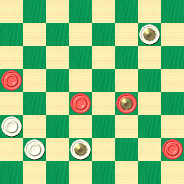
WHITE
Black Plays; White Draws
W:WK8,21,25,K26:B13,18,K19,28.
Forces are even (Black is about to get a second king), but in checkers we know that's only half the story. Black has superior mobility and that often means victory. It looks like White is going to have an historic struggle here just to pull out a draw.
Can you make personal history by solving the problem, or will you just be history? It's not something to become "historical" over; give it your best try and then click on Read More to see the solution and all the trimmings.![]()
Now You Dunne It

We think the poor fellow in the cartoon above is going to be in a lot of trouble in very short order. We only hope that he can somehow win the situation, but that's going to be quite a challenge.
Another kind of win that's a real challenge occurs in our game of checkers (although we'll bet it's easier than the situation depicted in the cartoon). It's known as Dunne's Win and it will be explained to us by Willie Ryan, as we quote from his classic Tricks Traps & Shots of the Checkerboard.
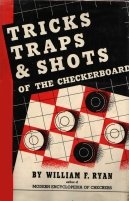
"Similar to the difficult George Dick Gambit, the ever practical Dunne's Win is a delicately balanced positional win that white is required to engineer by precise play.
Here's the run-up: 9-14, 22-17, 11-16, 25-22, 8-11, 22-18, 16-20, 18-9, 5-14, 29-25, 4-8---A, and we have the position depicted on the diagram, known as 'Dunne's Win.'
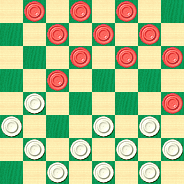
WHITE
White to Play and Win
W:W32,31,30,28,27,26,25,24,23,21,17:B20,14,12,11,10,8,7,6,3,2,1.
A---Black's position is hopeless after this move, with 22 pieces still on the board. The correct procedure is 11-15*, 25-22, 7-11*; now either 17-13 or 24-19 taxes black. For continuation, see Reisman's Pioneer Book, the leading authority on this formation."
Can you do this problem, or will you get Dunne on? When you Dunne done it, click on Read More to see the solution and notes.![]()
McCulloch's Masterpiece

There was a huge ranch recently for sale in McCulloch County, Texas. The sales literature called the 8,000 acre ranch a "masterpiece" and attached the same label to the property's 7500 square foot ranch home. Priced at just over 25 million dollars, we're reminded that this version of "McCulloch's Masterpiece" won't come cheap, though we have little doubt that it's worth every cent.
For better or worse, The Checker Maven doesn't have a budget that supports such high end investments; at times we have enough trouble just paying the bills. So today, we'll bring you a different "McCulloch's Masterpiece," one of the checker variety, and one that won't cost us--- or you--- anything at all. It's the latest entry in our Checker School series, and comes from Ben Boland's Famous Positions in the Game of Checkers.
WHITE
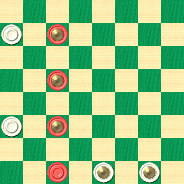
BLACK
Black to Play and Win
B:W28,12,K2,K1:BK27,K19,K11,3.
Don't bet the bank on this one, just enjoy solving it! When you've found the answer, click on Read More to cash in on the solution, three sample games, and detailed explanatory notes.![]()
Dick's Gambit

The photo above is of an iceboat named Dick's Gambit. It was taken by Michigan photographer Rick Wolanin, and is used with his kind permission. (You can see more of his work here.)
We can understand why the boat bears the "Gambit" moniker; ice-boating is a pretty wild and wooly endeavor. After all, a "gambit" is a deliberate risk taken in the hope of gaining something in return.
There are gambits in checkers, too; there is even "Dick's Gambit" although in this case we refer to checkerist George Dick. Willie Ryan featured Mr. Dick's gambit in Tricks Traps & Shots of the Checkerboard, and we're reprinting Willie's words for you today.

"As a general rule, an early losing move, when properly met, causes the game to deteriorate rapidly. The numerous early losses illustrated in this book prove that. However, there are some exceptions to this rule, as in the game below, where white makes a losing move on the eighth turn, yet is able to keep the game going for a long time, on the very fringe of tenability, only to succumb in the end to black's exacting play.
| 11-15 | 5-9 | 11-16 |
| 24-19 | 25-22---A | 18-15---E |
| 15-24 | 8-11 | 10-19 |
| 28-19 | 30-25---B, C | 22-17---F. |
| 9-14 | 12-16*---D | See the |
| 22-18 | 19-12 | diagram. |
A---A losing move---1. Although white is lost on the eighth play, with 22 pieces still on the board, this is one case where you can't count your checkers until they're hatched. The usual continuation for a draw at A is 26-22*, 8-11, 22-17, 11-16, 25-22, 16-20, 17-13, 4-8, 22-17, 8-11, 30-26, 11-15, 18-11, 7-16, 26-22, 2-7, 22-18, 7-11, 18-15, 11-18, 29-25, 3-8, 31-26, 8-11, 19-15, 10-19, 17-10, 6-15, 13-6, 1-10, 23-7, 15-18, 7-3, 19-23, 26-19, 16-23, 3-8, 11-16, 8-11, 16-19. James Hill.
B---If 22-17 is played at this point, black scores with: 9-13, 18-9, 13-22, 26-17, 6-22, 30-26, 11-15, 26-17, 15-24, 27-20, 10-15, 29-25, 15-19, 23-16, 12-19, 31-26, 4-8, 25-22, 8-11, etc. John Drummond.
C---If 27-24 is played, the win is clinched by black with: 11-16, 24-20, 3-8, 20-11, 8-24, 32-28, 4-8, 28-19, 8-11, 30-25, 1-5, 22-17, 9-13, 18-9, 5-14*, 25-22, 11-15, 19-16, 12-19, 23-16, 7-11, 16-7, 2-11, 26-23, 11-16. Wm. F. Ryan.
D---The only move to force the win, which proves that sometimes you must give a man to get a game.
E---Absolutely necessary, as black is threatening to win with 16-19.
F---Again forced, as 22-18 is suicide if black moves 16-20 in reply; while 32-28, 4-8, 22-17, 7-10, reverts to Note H."
1---A very long computer analysis says that this move is clearly inferior, but it's hard to interpret it as a dead loss at this point. It's interesting to watch the computer, as the analysis runs deeper and deeper, slowly increase its evaluation of Black's advantage, but after over half an hour, it still doesn't see a definite win---Ed.
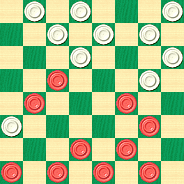
BLACK
Black fo Play and Win
B:W32,31,29,27,26,25,23,21,17,12:B19,16,14,9,7,6,4,3,2,1.
Solving this problem won't require a gambit on your part, or even a slippery ice-boat ride; all that's needed is substantive checker skill. Give it a try and then slide your mouse to Read More to see the solution.![]()
An Evening's Study

Study is usually a good thing; it's often an important part of the road to success in many an endeavor, checkers not the least among them. Sometimes, though, it gets a little overwhelming, and we sympathize with the poor student shown above, who seems to have gone into something like "study meltdown."
As today's entry in our Checker School series, we present a problem that the great checker writer Ben Boland called An Evening's Study. We suspect that there's enough material here for much more than a single evening, and we advise you to avoid the fate of our hapless student. Take your time and enjoy rather than trying to cram it all in at once.
BLACK
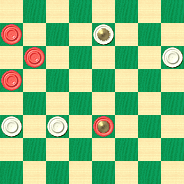
WHITE
White to Play and Win
W:W22,21,12,K7:BK23,13,9,5.
Will you be an "A" student on this one, or will your grade be somewhat lower? It's up to you; put in your study time and then click on Read More to see the solution, sample games, and detailed study notes.![]()
The Jaques Shot
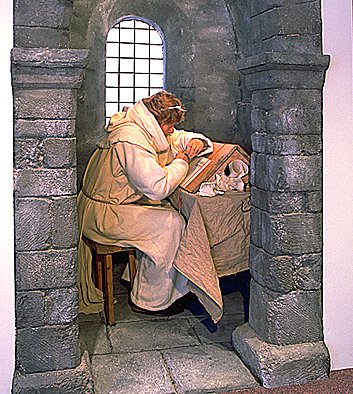
We've all heard the well-known French children's song Frere Jaques, but we'll guess that relatively few of us are familiar with its origins and possible meanings. Frere Jaques is usually translated as "Brother John," but "brother" can refer to a monk as well as a sibling. In fact, there's some evidence that Frere Jaques is related to Girolamo Frescobaldi's Fra Jacopino, lending credence to the "monk" theory.
We don't think Fra Jacopino, or Frere Jaques for that matter, were checker players, though perhaps they knew of an older version of the game. In any case, the subject of today's column, a different Jaques, was certainly a checkerist. Willie Ryan, in his seminal work Tricks Traps & Shots of the Checkerboard, gives us the scoop.

"One of the prettiest of all strokes is the much heralded Jacques Shot. E. Jacques, of Canada, used it for the first time in defeating a player by the name of Campbell, first name unknown. Invariably, writers have used the order of moves played in the Campbell-Jacques game to illustrate the stroke, but as explained in my note B, this invalidates the scientific value of the coup. It is neither practical nor advisable to make a losing move to bait a trap. Any experienced player knows better than to take such a risk. In my treatment of the Jacques stroke, the correct order of moves is given so that white can play for the shot without making a losing move at any point.
| 9-13 | 11-16 | 13-17 |
| 24-19 | 25-21 | 31-26---3 |
| 11-16 | 6-9 | 9-13---4 |
| 22-18 | 23-18 | 25-22 |
| 8-11 | 16-23 | 12-16 |
| 28-24 | 26-19 | 15-10 |
| 16-20 | 4-8---A | 2-7---C. |
| 18-14 | 29-25 | Now see the |
| 10-17 | 7-11---B | diagram. |
| 21-14 | 19-15 |
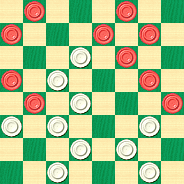
WHITE
White to Play and Win
W:W32,30,27,26,24,22,21,18,14,10:B20,17,16,13,11,8,7,5,3,1.
A---The following is much stronger---1, and almost makes the run-up on the Jacques Shot untenable: 13-17, 18-15* (the only move to draw), 9-18, 21-14, 18-22, 30-25*, 7-10, 14-7*, 2-18, 27-23*, 18-27 (20-27, 23-14, 22-26, 32-23, 26-30, 25-21, 1-6, 23-18, a draw), 25-18, 5-9, 32-23, 20-27, 31-24, 9-13, 19-15, 13-17, 18-14, 17-22, 14-10, 22-26, 23-19, 4-8, 24-20*, 26-31, 20-16, 31-27, 29-25*, 27-24 (27-23, 25-22*, 23-27, 10-6*, a draw), 16-11, 24-20, 11-4, 20-16, 4-8, 16-23, 15-11, 12-16, 8-12, etc.; a draw. Wm. F. Ryan.
B---If 8-11 is played here, then white's only move to draw is 25-22*---2. In the historical Campbell-Jacques game, 13-17 was played; white (Jacques) replied with 31-26, which loses for black by: 8-11, 32-28 (25-22, 11-15, black wins), 17-22, 26-17, 11-15, 19-10, 9-13, 25-22, 5-9, 14-5, 7-32, 24-19, 32-27, etc. F. F. Smith, Birmingham, England. However, if after 13-17 at B, white replies with: 18-15, 9-18, 21-14, a draw by black will be difficult. Hence, to reach the Jacques Shot scientifically without either side making a losing move, 7-11 must be played before 13-17, as the latter move virtually loses at this point.
C---The losing move, and it forms the great Jacques Stroke. Although this classical 12-piece clearance has been essayed and acclaimed by 1001 writers on the game, not one has ever attempted to show black's losing move, nor has any authority ever published the play leading up to the shot in the proper scientific sequence. This is not unlike a musician with rheumatic fingers trying to do justice to a fine rhapsody on a rusty instrument that is out of tune. My examination of the situation shows that instead of 2-7 at C, black can effect the following beautiful draw, two pieces short: 16-19*!, 24-15, 2-7*, 27-24, 20-27, 32-23, 5-9, 14-5, 7-14, 18-9, 11-27, 21-14, 3-7*!, 26-23, 27-31, 23-19, 13-17*!, 22-13, 8-11, 30-25, 31-27, 25-21, 27-23, 21-17, 23-16, 9-6, 1-10, 5-1, 16-12, 13-9, 10-15, 1-6, 11-16. Wm. F. Ryan. This draw is almost as good as the shot!"
1---The computer doesn't see any real difference between the two moves---Ed.
2---The computer gives 32-28 to draw and sees 25-22 as a possible White loss---Ed.
3---A probable loss for White; 30-26 was required here. We're a little surprised Willie missed this---Ed.
4---But Black gives away all the advantage. 11-16 likely would have won---Ed.
You don't need to be a monk, speak French or Italian, or be familiar with musical history to solve the problem diagrammed above. You do need to be a pretty good checker player, though. When you've found la solution (or should that be la soluzione?) click your mouse on Read More to check your work.![]()
2nd Edition of "How to Win at Checkers"

A revised and corrected 2nd edition of Fred Reinfeld's How to Win at Checkers is now available here or from the link on the right side of the page. The revised edition fixes a quirk in the rendering of the board diagrams and includes detailed errata graciously provided by Mr. George Hay. We hope you both enjoy and benefit from Mr. Reinfeld's classic work.
Subtle

An image such as the one above, unusual though it may seem, is filled with deep and and often subtle symbolism and meaning, unraveled only through careful consideration and study.
Today's entry in our Checker School series demonstrates once more that checkers too can be deep and subtle, with each move having its own meaning and significance. The problem shown below, first published over 140 years ago, is definitely not easy, but by any measure it is rewarding, satisfying, and entertaining, and we might even say, enlightening.
BLACK
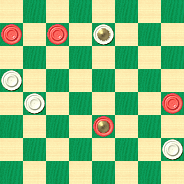
WHITE
White to Play and Draw
W:W28,17,13,K7:BK23,20,6,5.
Can you unravel the subtleties of this difficult position? Think deeply, and be careful of seemingly small nuances that loom large in the end. When you've unraveled the meaning of the problem, click on Read More to see the solution, sample games, and detailed explanatory notes.![]()
The Great Lewis Stroke

Golfer Stacy Lewis is executing quite a powerful and accurate stroke in the photo above, something that takes skill, strength, and timing.
Today's excerpt from Willie Ryan's Tricks, Traps & Shots of the Checkerboard brings us a similar example from the game of checkers. Attributed to the late Lawrence Lewis, skill, strength, and timing are all part of the picture here too. Now, we doubt that checkerist Lewis and golfer Lewis are in any way related, but we don't know if golfer Lewis plays checkers or for that matter if checkerist Lewis played golf. What we do know is that you'll certainly enjoy today's problem. Let's let Willie tell us more.

| 9-13 | 15-18---A | 13-17 |
| 22-17 | 29-25---B, 1 | 19-15 |
| 13-22 | 6-9 | 1-6 |
| 25-18 | 24-19 | 24-20---2 |
| 10-15 | 9-13 | 12-16---E |
| 18-14 | 28-24 | Now look at the |
| diagram. |
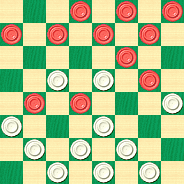
WHITE
White to Play and Win
W:W14,15,20,21,23,25,26,27,30,31,32:B2,3,4,5,6,7,8,11,16,17,18.
"White now sweeps the board with one of the best concealed strokes recorded in checker literature. It was first shown by the late Lawrence M. Lewis of Wheeling, West Virginia, who sprang it on me in a match at Flint, Michigan, in 1928, throwing the gallery of spectators into an uproar!
A---Tescheleit's Master Play says this move 'leads to a critical draw for black.' The figures featured in this study should disperse that claim.
B---Very weak, as it permits black to work in 6-9, tying up white's single corner development. Tescheleit prescribes 21-17 as the potent element in white's formation, but black has an equal game against it, as follows: 21-17, 11-15*---C, 29-25, 8-11, 17-13, 11-16*---D, 24-20 (if white adopts 24-19, 15-24, 28-19, then 6-10* puts black on the right track), 16-19, 23-16, 12-19, 27-23, 18-27, 32-16, 15-19* (a one-move redeemer), 16-11 (31-27, 4-8, 27-24, 8-12, 24-15, 12-19, 15-11, 7-16, 20-11, 6-9, ends in a draw), 7-16, 20-11, 3-7, 31-27, 7-16, and white has nothing to play for but a draw.
C---Given to lose by Tescheleit, but it is probably the only move to draw! Tescheleit shows 11-16 to draw, then 29-25, 16-20, 26-22, 12-16, 22-15, 7-10, 14-7, 3-26, 30-23, 5-9; now, instead of 17-14 as given in Master Play, 25-22, 8-12, 23-18. Now black hasn't a leg to stand on, and white wins.
D---Corrects and improves Tescheleit's Master Play, where 4-8 is played, white winning with: 25-21, 6-10, 23-19, 10-17, 21-14, etc. Recommended move seems to promote the draw without any real difficulty, indicating that the 15-18 move at A is no lame duck when properly managed in the structural stage.
E---Fatal. The guileless player would never suspect that a paralyzing coup was in the offing. Neither did I! The correct moves to a draw here are: 6-9, 26-22*, 17-26, 31-22, 12-16---F, 30-26*, 9-13---G, 15-10*, 11-15, 20-11, 7-16, 10-6*, 2-9, 14-10, 9-14, 10-6, 8-12---3, 6-2, 16-20, 2-6, 3-8 (if 12-16 is moved, the shot by 21-17 gains the draw), 6-10, 8-11, 10-19, 11-16, 22-15, 14-18, 23-14, 16-30, 14-10. Wm. F. Ryan.
F---If 9-13 is played, then follow with 23-19 for an easy draw; if 2-6 is played, then 14-10, 7-14, 22-17 will win.
G---Or 16-19, 23-16, 8-12, 15-8, 12-19, 22-15, 4-18, 14-10, 7-14, 27-23, 18-27, 32-16, 14-17, 21-14, 9-18, 16-11, 5-9, 20-16, 9-13, 25-21. Wm. F.Ryan."
1---24-19 was certainly better, though the computer doesn't agree that White has more than a small advantage---Ed.
2---Very poor, probably losing for White; 23-19 would have maintained the balance---Ed.
3---This gives up the Black advantage. Willie missed this Black win: 8-11 6-2 16-20 32-28 4-8 2-6 8-12 6-10 3-8 10x17 12-16 23x14 15-18 22x15 13x29 15-10 8-12 21-17 29-25 17-13 25-30 26-22 16-19 10-6 11-16 and now white has no defense against the coming 19-24. Black Wins---Ed.
You'll have to uncover some pretty spectacular moves to solve this one, but take a swing at it and try to drive to the solution. When you're done, click your mouse on Read More to see strength, power, and timing in action.![]()
The Checker Maven is produced at editorial offices in Honolulu, Hawai`i, as a completely non-commercial public service from which no income is obtained or sought. Original material is Copyright © 2004-2025 Avi Gobbler Publishing. Other material is public domain, AI generated, as attributed, or licensed under CC1, CC2,CC3 or CC4. Information presented on this site is offered as-is, at no cost, and bears no express or implied warranty as to accuracy or usability. You agree that you use such information entirely at your own risk. No liabilities of any kind under any legal theory whatsoever are accepted. The Checker Maven is dedicated to the memory of Mr. Bob Newell, Sr.

